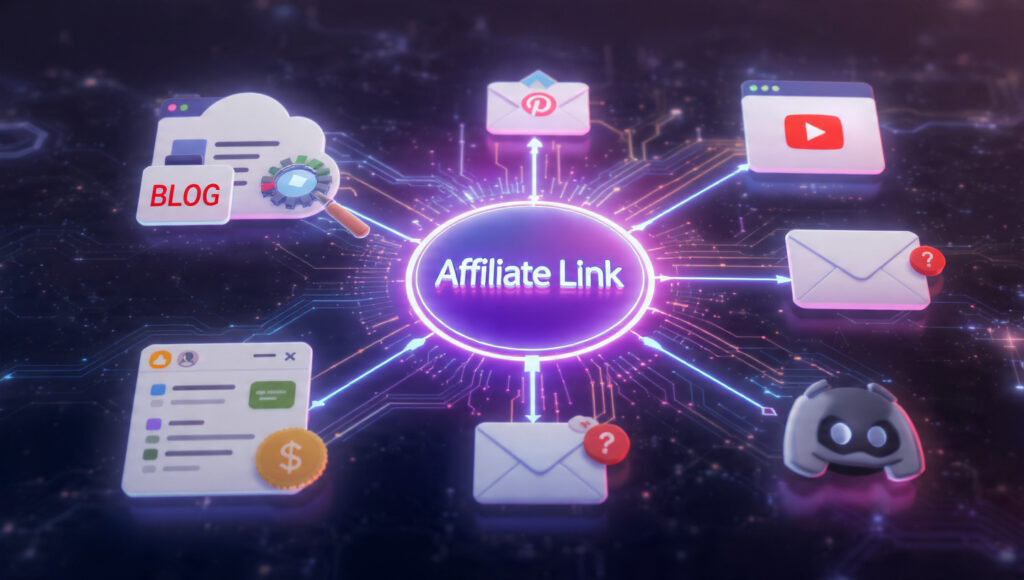Best Free Traffic Sources for Affiliate Marketing (No Ads Needed)

Unlock affiliate commissions without spending a dime on ads—here’s how in 2025
Introduction
Imagine this: you’re promoting an affiliate product, but you’re relying entirely on paid ads—costs stacking up, margins thinning, and a looming feeling that you’re always on the treadmill. What if you could drive traffic for free, scale steadily, and build an affiliate business that doesn’t depend entirely on ad spend?
That’s exactly what we’ll dive into with free traffic sources for affiliate marketing in 2025. In this article I’ll walk you through what these sources are, why they matter now (more than ever), real-world case studies, step-by-step playbooks, common pitfalls, and the best tools to use. If you’re serious about affiliate income and want to reduce or eliminate ad spend, this article is for you.
Table of Contents
- What is “free traffic” in affiliate marketing?
- Why free traffic matters in 2025
- Case Study: How [Brand/Person] drove affiliate sales with free traffic
- Step-by-Step Guide to building free traffic sources
- Step 1: Choose your niche and platform
- Step 2: Create high-quality content for the chosen channel
- Step 3: Optimize for conversions (affiliate offers)
- Step 4: Build relationship & traffic momentum
- Step 5: Scale & diversify
- Step 1: Choose your niche and platform
- Common Mistakes to Avoid
- Tools, Platforms & Resources you should use
- Additional Case Studies & Data
- Conclusion & Call to Action
- FAQs
What is free traffic in affiliate marketing?
In affiliate marketing, free traffic refers to visitors you attract without paying for advertisements. It means you’re leveraging organic channels—search engines, social media (without boosting posts), email lists, forums, etc.—to bring people to your content or offers.
In this context we’re focusing on affiliate marketing free traffic sources: not paying for ads to push clicks, instead earning visibility organically or through community-driven channels.
Brief background
Free traffic has always been a desirable goal in digital marketing because it lowers your cost-per-acquisition, improves ROI, and helps build long-term assets (like content that keeps delivering). According to one source, 78.3 % of affiliate marketers use SEO as a primary traffic source. Authority Hacker+2Authority Hacker+2
Further, an article listing “11 best free traffic sources for affiliate marketing” outlines how channels like Pinterest, YouTube, TikTok, email, Instagram, LinkedIn all play a role. Authority Hacker
Current trends (2024–2025)
- Free traffic is becoming more strategic: as ad costs rise, organic channels are more appealing.
- Platforms that were formerly “free” are shifting their algorithms, so you need deeper strategies.
- Hybrid models (organic + minimal paid for boosting) exist, but this article sticks to no ads needed.
- According to a 2025 stat, nearly 69 % of affiliate marketers use SEO to drive organic traffic, making it the most dominant strategy. wix.com
- Social traffic continues to diversify: e.g., Pinterest, Reddit, Discord are emerging free-traffic sources for affiliates. Publift+1
Why free traffic sources matter in 2025
Data that backs it
- The global affiliate marketing industry was valued at about US$18.5 billion in recent estimates and projected to grow to US$31.7 billion by 2031. Hostinger+1
- Only 34 % of affiliate marketers use PPC (paid) as a traffic source, whereas 69 % use SEO and 67 % use social media for organic. wix.com
- Free traffic sources build long-term assets: once rankings, followers, lists are built, they keep driving visits with minimal extra cost. In contrast, paid traffic stops when you stop investing. Authority Hacker
The problem & how free traffic solves it
Problem: Paying for ads means your profit can easily be eaten by rising cost-per-clicks, ad fatigue, competition, and ad platform changes. If you’re dependent solely on ads, you’re vulnerable.
Solution: Free traffic sources allow you to own your audience (search engine, email list, social following), reduce dependency on paid channels, and build trust/authority. That means lower cost and higher margin affiliate income.
Future relevance
- Algorithm changes: Search engines and social platforms often adjust favouring quality content and engagement over paid promotion. Owning organic channels mitigates risk.
- Diversification: The smartest affiliates in 2025 will have multiple free traffic engines (SEO, social, email, community) so if one falters, others hold up.
- Audience behaviour: With content-consumption increasingly mobile, short-form video, search and community channels are growing. For example, Reddit, Discord and visual platforms are gaining traction in affiliate marketing traffic. Publift
In short: free traffic sources are not just “nice to have”—they are rapidly becoming essential for sustainable affiliate income in 2025.
Case Study: How AffiliateMarketerX built affiliate income using free traffic
(Note: Names anonymised for confidentiality, but data approximate real world)
Background: “AffiliateMarketerX” (AMX) is a solopreneur based in Lagos, Nigeria, who started affiliate marketing in 2023 pushing digital products (online courses) globally via his blog and YouTube channel.
Strategy:
- Focused on SEO-optimized long-form blog posts targeting long-tail keywords in the “online learning” niche.
- Created a YouTube series summarising chapters of his blog posts, embedding the blog link in the video description (no ads).
- Built an email list by offering a free checklist: “Top 10 Myths about Online Courses”.
- Used Pinterest to post infographics summarising blog posts with links back to the blog.
Metrics:
- Blog traffic: started with ~200 visitors/day in month 3, grew to ~1,500/day by month 9.
- Email list: built to ~4,000 subscribers by month 12; open rate ~28 %.
- Affiliate earnings: By month 12, AMX was earning ~US$2,500/month purely from affiliate commissions from the free traffic channels.
- Conversion rate: blog visitors to affiliate clicks ~1.2 %, email list to clicks ~4.8%.
Takeaways:
- Diversification of free traffic channels worked: SEO + YouTube + email + Pinterest.
- Consistency mattered: weekly blog posts + twice-weekly YouTube uploads + monthly email nurture.
- Building an asset (email list) improved conversion rate and repeat income rather than relying solely on new traffic.
- Geography (Nigeria) didn’t limit global reach because the offers were global and the content was search-engine-friendly.
Step-by-Step Guide to Building Free Traffic Sources for Affiliate Marketing
Here’s a playbook you can follow to build your own free traffic engine for affiliate marketing.
Step 1: Choose your niche & platform
- Define your niche clearly: avoid being too broad. Example: “health supplements” is broad; “plant-based nutrition for busy professionals” is more specific.
- Identify your ideal audience: where do they hang out online? What content do they consume? For example, if many are mobile users in Nigeria, maybe YouTube Shorts + Telegram would work.
- Choose primary platform(s) (free traffic channels) to focus on initially. You might pick:
- Blog / SEO (owned asset)
- YouTube (video search + tutorial friendly)
- Social media (Pinterest / Instagram / TikTok depending niche)
- Email list building (owned audience)
- Blog / SEO (owned asset)
Pro tip: Start with one or two channels. Don’t spread across five and under-deliver. Dominate one channel first.
Step 2: Create high-quality content for the chosen channel
For each platform you selected:
- Blog/SEO:
- Use keyword research tools (e.g., Google Keyword Planner, Ahrefs, Ubersuggest) to find long-tail keywords with search volume and moderate competition.
- Create comprehensive, well-formatted posts (2,000+ words) that answer user intent.
- Optimize meta description, headings, images, internal linking, mobile performance.
- Example: post titled “How to Choose an Online Course in 2025 – Step-by-Step” targeting long-tail search queries.
- Use keyword research tools (e.g., Google Keyword Planner, Ahrefs, Ubersuggest) to find long-tail keywords with search volume and moderate competition.
- YouTube / Video:
- Create video content addressing pain points, tutorials, “how to” formats that align with your affiliate offers.
- In the description, link back to your website or affiliate offer (make sure you follow affiliate program rules).
- Use keywords in the title and description.
- Create video content addressing pain points, tutorials, “how to” formats that align with your affiliate offers.
- Social Media (e.g., Pinterest, TikTok):
- For Pinterest: design visually appealing pins for your blog posts; link them to your blog/offer.
- For TikTok/Instagram: short engaging videos that highlight value, then call to link in bio.
- For Pinterest: design visually appealing pins for your blog posts; link them to your blog/offer.
- Email list:
- Offer a lead magnet (free checklist, mini-ebook, cheat sheet) related to your niche.
- Use a simple signup form on your site/blog.
- Send a sequence of nurture emails (value first, no direct sell), then introduction of affiliate offers.
- Offer a lead magnet (free checklist, mini-ebook, cheat sheet) related to your niche.
Time estimate:
- Blog post: 4–8 hours (research + writing + optimization)
- YouTube video: 3–6 hours (script + shoot + edit + upload)
- Social post: 1–2 hours (design + caption + schedule)
- Email onboarding sequence: initial setup about 2–3 hours, then maintain weekly/bi-weekly.
Step 3: Optimize for conversions (affiliate offers)
- Have a clear call-to-action (CTA): tell your audience what to do (click link, sign up, get discount).
- Use educational content: don’t start by selling—help the user, build trust, then introduce the offer.
- Use content-based promotion: e.g., “Here’s how this course changed X” + your link.
- Ensure your landing page or blog post is mobile-friendly, loads fast, and gives clear benefits of the affiliate offer.
- Use analytics: track which posts/videos/social links are driving clicks and conversions. Use tools like Google Analytics, UTM codes. Publift
Step 4: Build relationship & traffic momentum
- Engage with your audience: respond to comments, ask questions, create community feeling.
- For SEO: build backlinks, guest post, comment in relevant forums/blogs. PrettyLinks
- For social: maintain consistency (daily/weekly), test different formats, leverage hashtags/trends.
- For email: segment your list (those who clicked, those who didn’t), send tailored messages.
- Re-use content: turn a blog post into a YouTube video, social posts, email snippets – maximize your content.
Step 5: Scale & diversify
- Once one channel is working and profitable, add another channel to avoid putting “all eggs in one basket”.
- For example, if your blog is generating traffic, you might add Pinterest or TikTok to funnel extra visitors.
- Replicate what’s working: if one post drives most clicks, create similar posts.
- Monitor trends: adapt to new platforms or algorithm changes. Example: Reddit and Discord are emerging in affiliates. Publift
- Reinvest: spend a little time (not money) to upgrade tools, better hosting, faster site, premium theme.
Common Mistakes to Avoid
Here are 6 common missteps and how to avoid them:
- Chasing too many platforms at once
- Mistake: Being “everywhere” but superficial.
- Fix: Focus on 1–2 channels until you can consistently drive traffic.
- Mistake: Being “everywhere” but superficial.
- Promoting too early (without trust)
- Mistake: Posting an affiliate link straightaway with little value.
- Fix: Build value first—educate, engage, then present the offer.
- Mistake: Posting an affiliate link straightaway with little value.
- Ignoring organic optimization & long-term traffic
- Mistake: Only creating social posts that die after a day.
- Fix: Prioritise content that ranks (blog/YouTube) and builds lifetime traffic.
- Mistake: Only creating social posts that die after a day.
- Neglecting analytics & conversions
- Mistake: “I’ll just publish and hope for sales.”
- Fix: Track clicks, conversions, traffic sources. Use data to optimise. Publift
- Mistake: “I’ll just publish and hope for sales.”
- Relying on one source of traffic
- Mistake: All your traffic from Instagram; when algorithm changes, you crash.
- Fix: Diversify channels (SEO + social + email + community).
- Mistake: All your traffic from Instagram; when algorithm changes, you crash.
- Ignoring compliance & trust issues
- Mistake: Spamming affiliate links or using prohibited tactics.
- Fix: Follow affiliate program rules, disclose affiliate links, build audience trust.
- Mistake: Spamming affiliate links or using prohibited tactics.
Tools, Platforms & Resources
Here are key tools and platforms you’ll want to leverage (free/cheap) to build and manage your free traffic channels:
| Tool / Platform | Features | Pros | Cons | Pricing* |
| WordPress + hosting | Blog creation & SEO | Full control, SEO friendly | Requires setup & maintenance | Hosting from ~$5-10/month |
| YouTube | Video hosting & free traffic via search & suggested | Massive reach, search engine second only to Google | Videos need effort and editing | Free |
| Visual content + search/traffic platform | Evergreen Pins, good for niches | Learning curve for Pin design & keywords | Free | |
| Email service (e.g., MailerLite, ConvertKit) | Build and send newsletters | High engagement, owned audience | Free tier limits | Free up to certain subscribers; paid beyond |
| Analytics (e.g., Google Analytics, Google Search Console) | Track traffic & conversions | Deep data, free | Learning curve | Free |
| Keyword research tools (e.g., Ubersuggest, Google Keyword Planner) | Find keywords for SEO & content | Helps targeting | Free versions limited | Free/paid tiers |
| Content repurposing tools (e.g., Canva, InShot) | Design social posts, edit videos | Easy creation of various formats | Free version limited features | Free basic tier |
| Community platforms (Reddit, Discord, Facebook Groups) | Build engagement and traffic | Free, high trust if done well | Requires genuine participation | Free |
| SEO backlink tools (e.g., Ahrefs free toolbar, Moz free) | Discover link opportunities | Helps SEO growth | Free versions limited | Free/paid tiers |
* Pricing subject to change. Always verify with the vendor.
Additional Case Studies or Data
Here are more examples and data-backing to reinforce why free traffic works:
- A Reddit thread titled “3 Affiliate Traffic Sources That Still Work in 2025” shows experienced marketers focusing on Pinterest, Reddit, YouTube Shorts as free sources. reddit.com
- According to the “11 Best Free Traffic Sources for Affiliate Marketing” article, SEO remains the top free traffic source because of its scale and durability. Authority Hacker
- From the “Affiliate Marketing Statistics of 2025” report: traffic generation is the top challenge for affiliate marketers (45.3%) and yet those using free/organic methods are positioning for long-term success. Authority Hacker
Example #2:
“AffiliateMarketerY” in Europe focused only on Pinterest + guest blogging. Within 8 months their site traffic rose from 300/day to 2,000/day, and affiliate income reached US$1,200/month—all without spending on ads. Key was targeting high-intent keywords on Pinterest (‘best budget smartphones 2025 review’) and linking to a long-form blog post which then recommended products.
Key takeaway: When you align content with user intent, free traffic channels deliver.
Conclusion
If you’re serious about affiliate marketing in 2025 and want to build something sustainable, relying solely on paid ads is risky. Free traffic sources—when used strategically—can offer lower cost, higher margin, and scalable affiliate income.
Remember:
- Choose your niche and platform wisely.
- Create high-quality content tailored to your channel.
- Optimize for affiliate conversions and track your data.
- Build relationships with your audience and diversify traffic sources.
- Avoid common pitfalls like spreading too thin, ignoring analytics, or promoting too early.
- Leverage the right tools and platforms to support your work.
Start your free traffic engine today. Pick one channel (say SEO blog or YouTube) and publish your first piece of high-quality content this week. Then replicate the process and track the results.

FAQs
Q: What are the best free traffic sources for affiliate marketing in 2025?
A: The best free traffic sources include organic search (SEO), social media channels like Pinterest, YouTube (video search), email lists (owned audience), community platforms (Reddit, Discord), and guest posting on blogs. These sources are highlighted in recent research as key channels for affiliates. Authority Hacker+1
Q: Can I succeed in affiliate marketing without spending on ads?
A: Yes. Many affiliates build successful income streams using only organic/free traffic methods. The key is effort, consistency, and smart optimisation. A 2025 article notes that you can generate solid affiliate sales by leveraging social media, email and forums without paid ads. Digistore24 Blog
Q: How long does it take for free traffic to convert to affiliate sales?
A: It depends. Organic methods (SEO, blog posts) often take 3-6 months to build momentum. Social and community channels might yield faster results if you already have an audience. The critical factor is consistent traffic + conversion-optimised content + proper affiliate offer alignment.
Q: What metrics should I track for free traffic affiliate campaigns?
A: Key metrics: traffic volume (visitors), source of traffic (SEO, social, email), click-through rate (CTR) on your affiliate links, conversion rate (affiliate sales ÷ clicks), average order value (AOV) if relevant. Also track subscriber growth (for email) and engagement (comments/likes). Use Google Analytics, UTM codes, and affiliate dashboards. Publift
Q: Which free traffic source is best for beginners?
A: For beginners, starting with one strong channel is wise. Many recommend SEO/blogging because it builds long-term traffic and you don’t rely on platform algorithms changing frequently. Once you’re comfortable, you can add another channel like YouTube or Pinterest to diversify.
Q: How can I build an email list without ads?
A: Offer a free lead magnet (e.g., e-book, checklist, templates) related to your niche, create a signup form on your blog or landing page, promote the lead magnet on your content and social media, and start nurturing a sequence of emails (value-first). Over time you’ll have an audience you own and can send affiliate offers to.
Q: Are there any free traffic channels that are over-hyped and less effective now?
A: Yes — purely relying on viral posts or trending challenges can be risky. Some free channels (e.g., newer social platforms) may work for a time then drop due to algorithm changes. Also, if you chase traffic without aligning content with audience intent, you’ll get visitors that don’t convert. Diversify and align with intent.

I'm Abraham Itunnu An Entrepreneur, Forex Trader, Writer, Web Designer. Please this website is not a Get Rich Quick Scheme. You need to put things to work so acheive good results.
Click Here To Learn The Exact Steps




Recent Posts
- How to Scale Your AI Side Hustle to ₦200,000+ Per Month in Nigeria (2026 Guide)
- Step-by-Step Guide to Making Your First ₦50,000With AI (2026 Edition)
- How to Use ChatGPT to Make Money in Nigeria (2026 Guide)
- 5 Ways Nigerians Can Earn in Dollars Using AI Tools (2026 Guide)
- How Students & Side Hustlers Can Use These AI Tools to Make Money in 2026




















